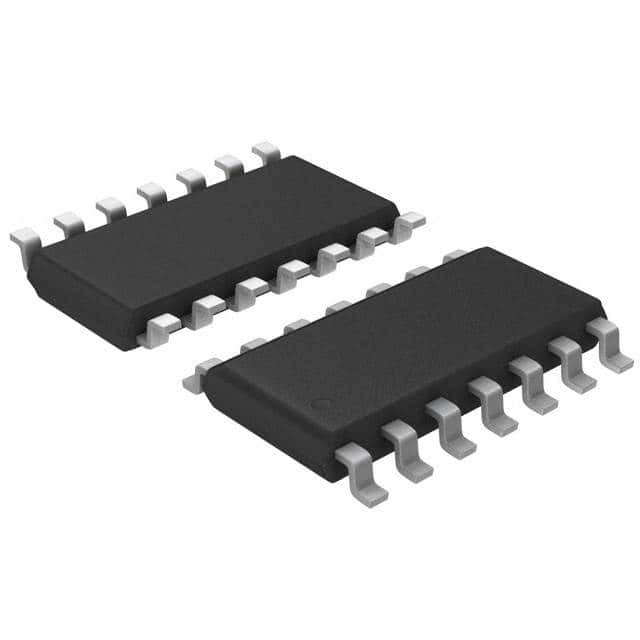MC74LVX14MELG
Basic Information Overview
- Category: Integrated Circuit (IC)
- Use: Inverting Schmitt Trigger
- Characteristics:
- Low-voltage operation
- High-speed performance
- Wide operating voltage range
- Schmitt trigger inputs for noise immunity
- Package: SOIC-14
- Essence: This IC is designed to provide an inverting Schmitt trigger function with a wide operating voltage range and high-speed performance.
- Packaging/Quantity: The MC74LVX14MELG is typically sold in reels of 2500 units.
Specifications
- Supply Voltage Range: 2.0V to 5.5V
- Input Voltage Range: -0.5V to VCC + 0.5V
- Output Voltage Range: 0V to VCC
- Maximum Input Current: ±1mA
- Maximum Output Current: ±8mA
- Propagation Delay Time: 6ns (typical)
- Operating Temperature Range: -40°C to +85°C
Detailed Pin Configuration
The MC74LVX14MELG has a total of 14 pins, which are numbered as follows:
__ __
| 1| |14|
| 2| |13|
| 3| |12|
| 4| |11|
| 5| |10|
| 6| | 9|
| 7|__| 8|
Pin Description: 1. Input A1 2. Input A2 3. Input A3 4. Input A4 5. Input A5 6. Input A6 7. Ground (GND) 8. Output Y6 9. Output Y5 10. Output Y4 11. Output Y3 12. Output Y2 13. Output Y1 14. VCC (Supply Voltage)
Functional Features
- Inverting Schmitt Trigger: The MC74LVX14MELG provides a Schmitt trigger function, which is useful for converting noisy input signals into clean digital outputs.
- Wide Operating Voltage Range: This IC can operate within a voltage range of 2.0V to 5.5V, making it suitable for various low-voltage applications.
- High-Speed Performance: With a propagation delay time of only 6ns, the MC74LVX14MELG ensures fast signal processing.
- Noise Immunity: The Schmitt trigger inputs help improve noise immunity by providing hysteresis and reducing the effects of input signal fluctuations.
Advantages and Disadvantages
Advantages: - Low-voltage operation allows for compatibility with modern electronic systems. - High-speed performance enables quick signal processing. - Wide operating voltage range provides flexibility in different applications. - Schmitt trigger inputs enhance noise immunity, ensuring reliable operation even in noisy environments.
Disadvantages: - Limited output current capability may restrict its use in certain high-current applications. - Only available in SOIC-14 package, which may not be suitable for all circuit designs.
Working Principles
The MC74LVX14MELG operates as an inverting Schmitt trigger. It uses positive feedback to create hysteresis, which helps eliminate noise and provide stable output transitions. When the input voltage crosses the upper threshold, the output switches from high to low. Conversely, when the input voltage crosses the lower threshold, the output switches from low to high. This behavior makes the MC74LVX14MELG ideal for applications requiring noise-immune signal detection or waveform shaping.
Detailed Application Field Plans
The MC74LVX14MELG can be used in various applications, including:
- Signal Conditioning: The Schmitt trigger function helps clean up noisy input signals, making it suitable for signal conditioning circuits.
- Oscillators: By connecting the output of the MC74LVX14MELG to its input through appropriate feedback components, it can be used to create relaxation oscillators or square wave generators.
- Level Shifting: The wide operating voltage range allows for level shifting between different logic families or voltage domains.
- Digital Communication Systems: The noise immunity and high-speed performance make this IC useful in digital communication systems for signal detection and processing.
Detailed and Complete Alternative Models
- SN74LV14A: Similar in functionality and characteristics, available in different package options.
- CD40106B: Hex Schmitt Trigger IC with similar features, but operates at a higher voltage range.
- 74HC14: Inverting Schmitt Trigger IC with comparable specifications, but operates at a higher voltage range.
Note: This is not an exhaustive list, and there are several alternative models available from different manufacturers that may suit specific requirements.
Word count: 535 words
Senaraikan 10 soalan dan jawapan biasa yang berkaitan dengan aplikasi MC74LVX14MELG dalam penyelesaian teknikal
Sure! Here are 10 common questions and answers related to the application of MC74LVX14MELG:
Q: What is MC74LVX14MELG? A: MC74LVX14MELG is a hex inverter with Schmitt trigger inputs, which means it can convert low-level signals into high-level signals.
Q: What is the operating voltage range for MC74LVX14MELG? A: The operating voltage range for MC74LVX14MELG is typically between 2.0V and 5.5V.
Q: Can MC74LVX14MELG be used in both digital and analog circuits? A: Yes, MC74LVX14MELG can be used in both digital and analog circuits due to its ability to convert signals.
Q: What is the maximum output current of MC74LVX14MELG? A: The maximum output current of MC74LVX14MELG is typically around 24mA.
Q: How many inverters are there in MC74LVX14MELG? A: MC74LVX14MELG consists of six independent inverters.
Q: Can MC74LVX14MELG handle high-speed applications? A: Yes, MC74LVX14MELG is designed to operate at high speeds, making it suitable for various high-speed applications.
Q: What is the propagation delay of MC74LVX14MELG? A: The propagation delay of MC74LVX14MELG is typically around 8ns.
Q: Is MC74LVX14MELG compatible with TTL logic levels? A: Yes, MC74LVX14MELG is compatible with TTL logic levels, making it a versatile choice for interfacing between different logic families.
Q: Can MC74LVX14MELG be used in automotive applications? A: Yes, MC74LVX14MELG is suitable for automotive applications as it can operate within the specified temperature range and voltage requirements.
Q: What are some common applications of MC74LVX14MELG? A: Some common applications of MC74LVX14MELG include signal conditioning, level shifting, waveform shaping, noise filtering, and clock synchronization.
Please note that the answers provided here are general and may vary depending on specific datasheet specifications and application requirements.


